This article was co-authored by Trudi Griffin, LPC, MS. Trudi Griffin is a Licensed Professional Counselor in Wisconsin specializing in Addictions and Mental Health. She provides therapy to people who struggle with addictions, mental health, and trauma in community health settings and private practice. She received her MS in Clinical Mental Health Counseling from Marquette University in 2011.
There are 20 references cited in this article, which can be found at the bottom of the page.
This article has been viewed 31,108 times.
Eating disorders include having attitudes, beliefs, and behaviors about food and body image that arise from negative feelings associated with food.[1] Behaviors can range from restricting food intake, throwing up after meals, bingeing on foods, and compulsively overeating. If you are ready to treat an eating disorder, you probably are already aware that you struggle to have a healthy relationship with food. It can be hard to admit you have a problem, but it can be even harder to reach out and start treating it. Be aware that many others have worked through the emotional problems associated with eating disorders and you can, too.
Steps
Reaching Out for Help
-
1Contact a mental health professional. At the heart of eating disorders is often extreme pain, problems with self-worth, shame, and difficulty expressing emotions.[2] The best person to tell is a counselor who should have the training and resources to help you get started in recovery. Eating disorders are life-threatening and, while teachers, friends, and loved ones all care for you and are well-meaning, it is essential you speak to a professional who can get you help and that you can trust.
- If you are in junior high or high school, talk to the school counselor. If your school doesn't have one, speak with the nurse about what you're going through.
- If you are in college, there may be counselors available on campus to speak with. You may also have access to a health center with a medical doctor on staff. Many larger universities do, especially if they offer a wide range of studies, which include nursing and medical school.
- If you are an adult, search for a mental health professional who specializes in eating disorders. Try using this website or this one to begin your search if you live in the US. Outpatient therapy is also a good place to start when beginning the road to recovery, and can help address the emotional needs that accompany eating disorders.[3]
- Dialectical Behavioral Therapy (DBT) and Cognitive Behavioral Therapy (CBT) are beneficial therapeutic practices when treating eating disorders.[4] These approaches help you challenge your thoughts and feelings, which are crucial to examine in eating disorders.
- Family therapy is often a strong component in treating eating disorders. Families may need a better understanding of eating disorders and how to relate to a family member with an eating disorder in an understanding way. Sometimes, family dynamics may make an eating disorder worse.
- Many people have been treated successfully for eating disorders and no longer suffer emotionally. They end up living happy, peaceful, and fulfilling lives.
-
2Contact a medical professional. Eating disorders, particularly anorexia, can cause significant harm to your body and can even lead to death. Take your health seriously. Receive a full medical evaluation from your medical practitioner and determine the state of your health. An evaluation can reveal any underlying health problems that you may be suffering due to your eating disorder, such as osteoporosis, abnormally slow heartbeat, severe dehydration/kidney failure, gastric rupture, or peptic ulcers.[5]
- By taking care of your body, you can begin to nourish yourself and build a better relationship between your mind, body, and emotions.
- Be sure to follow up with your medical professional regularly throughout your recovery.
- If you have bulimia nervosa or binge-eating disorder, your doctor may prescribe fluoxetine (Prozac) to help reduce binge episodes.
- Mortality rates in people who do not treat their eating disorders is high.[6] In order to give yourself the best chance at a long and healthy life, seek medical and psychological treatment.
Advertisement -
3Monitor mental health. If you suffer from depression or anxiety or any other mental health disorder, make sure these issues are being addressed with therapy, and/or medication.[7] Therapy will teach you the coping skills you need to get healthy and deal with the stressors of life. If you are feeling anxious or depressed, you may be more at risk to jump back to disordered eating habits, so it is essential you work on these skills.
- Many people who suffer from eating disorders have a history of trauma, including neglect in childhood, bullying, physical abuse, or sexual abuse that has led to low self-worth.[8] It's important to talk about these feelings and resolve these traumas through working with a therapist.
-
4Support yourself with good family and friends. Surround yourself with people who love and support you. Keep the people that want you to be happy and healthy. Stay away from people who encourage disordered eating habits or make you feel bad about your body.[9]
- You may need to find different friends or friend groups to help you avoid triggers. Surround yourself with people who want to love and support you, not bring you down. Ignore any judgments from anyone.
-
5Consider inpatient or residential treatment. Long-term inpatient treatment is good for individuals who cannot manage their psychological and/or medical symptoms on their own and need more intense care. Inpatient treatment means going to a specialized eating disorder center to receive more acute medical and psychological care. Residential treatment is for people more medically stable and often focuses more on psychological treatment with medical support. Many places also work with dietitians and help plan or provide food options.[10]
- If you feel like you need more support than weekly therapy, or are struggling significantly with medical and psychological symptoms, seek inpatient or residential care.
Understanding Symptoms
-
1Recognize the emotional symptoms of eating disorders. While eating disorders can vary from one person to another, some symptoms are similar across all eating disorders. Most people with disordered eating are overly concerned with their body, weight, and appearance. Emotional symptoms include:
- Preoccupation with food and counting calories
- Fears of certain foods, like those containing fat
- Intense fear of gaining weight or of being “fat”
- Perception and self-esteem based in body perception
- Avoiding situations involving food
- Frequently weighing oneself
- Denial of eating problems or weight loss
- Withdrawal from friends
-
2Look for symptoms of anorexia. It can be hard to determine what is healthy and unhealthy weight loss for each person. If weight loss and negative feelings about your body preoccupy your thoughts, you are not and will not be happy with your appearance, and you think you are fat regardless of how much weight you lose, you may be at risk for anorexia. Anorexia is a serious medical condition that people have died from. Some symptoms of anorexia include:[11]
- Extreme food restriction
- Extreme thinness, emaciation
- Inability to maintain a healthy weight, pursuit of being thinner and thinner
- Loss of menstruation in women and girls
- Dry, yellowish skin and brittle hair
- Low blood pressure
-
3Recognize symptoms of bulimia. Bulimia is characterized by eating large quantities of food (bingeing) and then preventing weight gain by vomiting, using laxatives or other pills or exercising excessively.[12] Most individuals suffering from bulimia tend to be of average weight or sometimes slightly heavier. Symptoms of bulimia include:[13]
- Eating large amounts of food at one time
- Feeling out of control while eating
- Eating when you feel full
- Eating until you feel sick
- Finding comfort in food after feeling sad or lonely
- Immediately vomiting or taking laxatives or exercising after eating
- Bingeing and/or purging in secret
- Having worn tooth enamel
- Sore or swollen throat
-
4Watch for symptoms of Binge Eating Disorder. Binge eating, also called compulsive overeating, occurs when a person eats an excessive amount of food, but does not take any actions afterward to lose weight. When bingeing, you may feel a loss of control or a depersonalization when eating. Binge eaters tend to be overweight or obese. The bingeing behavior tends to result in feelings of shame and embarrassment, which can lead to more bingeing.[14]
Changing Harmful Habits
-
1Identify your triggers. You may be triggered by looking at images of skinny women, browsing pro-ana websites, preparing for swimsuit season, or dealing with stress around exams or anniversaries of a painful event. Be aware of when you feel vulnerable to revert back to disordered eating.[15]
- Once you identify your triggers, have a plan for how to handle them. You may want to call your sister or best friend, say a prayer, or call a therapist.
- Your therapist can help you learn healthy ways to cope when you are triggered.
-
2Avoid dieting. Dieting can be like telling a child not to play with a fun toy: once it's out of reach, it becomes more desirable. This can be true for eating disorders, too. Once certain foods are off limits, they may become more tempting, and if you eat them, you perpetuate guilt and shame. Dieting can provoke cravings and compulsive eating.[16]
- Work with a dietitian to help you get back on track to healthy eating.
- You may choose to engage in being vegetarian or vegan, but assess your motivations. If choosing to be vegan is a way to restrict your food instead of a purely health-related or moral choice, reconsider this lifestyle.[17]
- Allow yourself the occasional treat. If you enjoy brownies or cheeseburgers, allow yourself to have one occasionally. Food is meant to nourish us and also to enjoy. It's important to eat foods you like and enjoy.
-
3Reduce exercise. If you excessively exercise, consider cutting down on your exercise habits.[18] Exercise is healthy for you, as is food, but both are good in healthy, balanced amounts. Too much or too little can be damaging to your body.
- Reducing exercise doesn't mean cutting it out completely, but you may want to take a temporary break for a bit to help your body reset if you've been putting a lot of stress on it. Consult with a medical professional when you're ready to change your exercise habits.
- Let exercise be something you do to honor and love your body, not break it down or make it lose weight.
-
4Improve your body image. Stop engaging in talk that puts down your body or other people's bodies.[19] This includes commenting on celebrities' bodies, too. Train yourself to get out of the mindset of putting yourself and others' appearance down. And don't let people around you talk negatively about their bodies, either.
- List the positive qualities of your body. They don't need to be connected with your weight; maybe you appreciate your curly hair or the color of your eyes, or the fact that you have an outie belly button. You have beautiful parts of your body that get neglected when you focus only on what you perceive as ugly.
- It might be hard to receive a compliment without finding a way to put yourself down, but smile and say: “Thank you.”
- If you hear other people talking negatively about their bodies, remind them that it's important to treat yourself and others kindly.
- Avoid situations that encourage fat shaming, whether related to media, friends, or in magazines.
-
5Practice mindful eating. Instead of focusing on the negative associations with food, pay attention to the act of eating. Spend time practicing awareness when you eat. Create time to eat and sit down. Give thanks for the food in front of you. Take a moment before eating to visually enjoy your food: look at the colors, textures, and arrangement. Smell your food and notice your mouth salivating. When you are ready to eat, chew slowly and enjoy the tastes, textures, and smells.
- When you eat, be present with the experience. Turn off the TV and remove other distractions. Set down your fork between bites, and try to concentrate on the smell, texture, taste, temperature, even the sounds of the food you are consuming.[20] If your mind wanders, that's okay, just try to guide it gently back to the present moment.
- Mindful eating involves making a conscious choice to eat and to determine what you eat.[21] When struggling with mindful eating, tell yourself, "I will eat my breakfast to nourish my body because I love myself."
- When struggling with previously avoided foods, tell yourself, "I am making the choice to eat this brownie for dessert because I enjoy it."
-
6Challenge negative self talk. You may not even realize how many negative thoughts go through your mind. When you become conscious of your negative thoughts, stop and observe them. Then, engage with the thought.
- Ask if the thought is based in reality (Is there any fact or is this just an interpretation?).
- Look for alternate explanations (Is there a more positive way to approach this? Can there be other meanings?).
- Put the thought into perspective (Is it possible you are catastrophizing the situation, or expecting the worst? Will it matter in two years?).
- Use goal-oriented thinking (Is there a way to approach this situation that helps me achieve my goals? Is there something I can learn from this?).[22]
- If you have the thought: “I am fat and nobody likes me”, observe the thought and begin challenging. You might ask yourself: "Is it true that nobody likes me? No, I have my best friend and my dog, and I know they love me." Or: "Am I actually fat? I only weight 110 pounds and I'm 5'8", and that's underweight. Also, my friends tell me I'm too thin. Even if I was fat, I am still lovable and loving."
Adjusting Your Mentality
-
1Listen to your body. If you have disordered eating, you are in the habit of ignoring your body's signals. You must learn to focus on listening closely to your body. Let your body communicate when it is hungry, and then listen to it. When your body has had enough food, it will feel content. Not bloated or in pain, but content. The same is true for exercise: your body will give you signs that it has had enough activity such as feeling tired or exhausted. The key here is learning moderation.
- Your body will tell you when to eat and when to stop eating, when it wants exercise and when it's had enough exercise. Learn to trust your body's messages, and most importantly, listen to them. Trust your body's innate ability to communicate these messages to you.
- If you overate or engaged in binge eating in the past, learn to listen closely to your body and any signals it has for you to denote hunger and satiation.
-
2Pay attention to your emotions. Do you reach for food when you feel happy, stressed, or sad? Or do you punish yourself for your emotions by restricting food? Some people run away from their unpleasant emotions by taking out those emotions on food. Challenge yourself to face your emotions and allow yourself to actually feel them. Recognize that eating disorders have more to do with avoiding unpleasant emotions than with food.[23] Refusing to eat is one way to practice self-control, while binge eating may be a way to comfort yourself in distress or sadness and purging may be a way you punish yourself.
- Think about what feelings drive your eating habits, and remember that “fat” isn't a feeling. You may struggle with self-worth and self-esteem problems. When your attention turns to food, what happened right before? Were you focused on a perceived shortcoming, loneliness, or sadness? Figure out what emotions drive your disordered eating.
-
3Find healthy ways to cope. Once you figure out what emotions you struggle to acknowledge, find ways to cope with those emotions and ways to cope with stressors when they arise. Not everybody copes in the same way, so it may take some time to figure out what helps you work through your problems. Try different techniques and discover which ones work best for you. Some techniques to try include:[24]
- Calling a friend or family member
- Listening to music
- Playing with a pet
- Reading a book
- Taking a walk
- Writing
- Going outside
-
4Manage your stress. Learn to cope with the struggles of everyday in ways that are not related to food. Engaging in activities each day that help you manage stress keeps stress from becoming overwhelming.[25] By making stress management a part of every day, you can address stress as it occurs instead of letting it build up.
- Practice light yoga, meditation, and relaxation exercises.
- Try progressive muscle relaxation. Lie down and relax your body, breathing more and more deeply as you relax. Starting with your right fist, tense the muscles, then relax. Then move to your right forearm and then to your upper arm, tensing then relaxing. Move through your right arm, then left arm, face, neck, back, chest, hips, and each leg and foot. You should feel very relaxed throughout your entire body, not carrying any tension in your muscles.
-
5Accept yourself. Eating disorders are active protests in denying the needs of your emotions and your body. Learning to accept yourself as you are may be a painful and long-term process. Accept who you are on all levels: body, mind, spirit, and emotions.
- Make a list of your positive qualities. You might be intelligent, creative, artistic, a math whiz, kind, caring, and compassionate. You have beautiful things to add to the world; acknowledge them!
- Combat negative thoughts about appearance with statements about who you are as a whole. When you find yourself critical of your appearance, transition your focus to things that make you feel valuable that are outside of your looks. These can include your kindness, generosity, intelligence, and skills. Remind yourself that your value is not your appearance, but who you are.
-
6Trust yourself. A big part of eating disorders is taking control over your body's natural processes by imposing control over them. Allow yourself to release the control of your mind and begin to trust yourself. You may have created food rules (“I don't eat red foods” or “I can't eat food high in carbs like bagels”), but allow yourself to challenge your own rules. Start slow, and stay present.
- Reflect on what it felt like to break a “rule”. Did you feel anxious before? What about during? How do you feel afterward? How did your body respond? Learn to improve the relationship you have with food, and begin to enjoy the process instead of dread it.
References
- ↑ https://www.psychiatry.org/patients-families/eating-disorders/what-are-eating-disorders
- ↑ http://www.helpguide.org/articles/eating-disorders/eating-disorder-treatment-and-recovery.htm
- ↑ http://www.nationaleatingdisorders.org/treating-eating-disorder
- ↑ http://www.ncbi.nlm.nih.gov/pmc/articles/PMC2928448/
- ↑ https://www.nationaleatingdisorders.org/health-consequences
- ↑ http://archpsyc.jamanetwork.com/article.aspx?articleid=1107207
- ↑ http://www.mayoclinic.org/diseases-conditions/mental-illness/basics/treatment/con-20033813
- ↑ https://www.nationaleatingdisorders.org/sites/default/files/ResourceHandouts/TraumaandEatingDisorders.pdf
- ↑ http://www.helpguide.org/articles/eating-disorders/eating-disorder-treatment-and-recovery.htm
- ↑ http://www.nationaleatingdisorders.org/treatment-settings-and-levels-care
- ↑ http://www.nimh.nih.gov/health/topics/eating-disorders/index.shtml
- ↑ https://www.nlm.nih.gov/medlineplus/ency/article/000341.htm
- ↑ http://www.nimh.nih.gov/health/topics/eating-disorders/index.shtml
- ↑ http://www.nimh.nih.gov/health/topics/eating-disorders/index.shtml
- ↑ http://www.helpguide.org/articles/eating-disorders/eating-disorder-treatment-and-recovery.htm
- ↑ http://eating-disorders.org.uk/information/compulsive-overeating-binge-eating-disorder/
- ↑ https://www.independent.co.uk/news/long_reads/veganism-orthorexia-dieting-anorexia-food-bloggers-diet-vegans-a8537211.html
- ↑ http://www.nimh.nih.gov/health/topics/eating-disorders/index.shtml
- ↑ https://www.psychologytoday.com/blog/diet-is-4-letter-word/201402/how-do-i-improve-my-body-image
- ↑ https://www.psychologytoday.com/blog/mindful-eating/200902/mindful-eating
- ↑ http://www.tandfonline.com/doi/abs/10.1080/10640266.2011.533605
- ↑ http://psychcentral.com/lib/challenging-negative-self-talk/
- ↑ https://www.eatingdisorderhope.com/information/eating-disorder
- ↑ https://eatingdisorderfoundation.org/learn-more/about-eating-disorders/coping/
- ↑ http://www.helpguide.org/articles/eating-disorders/binge-eating-disorder.htm
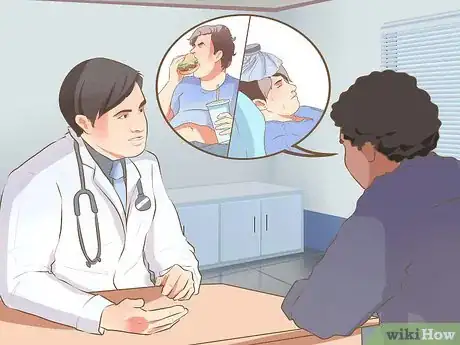
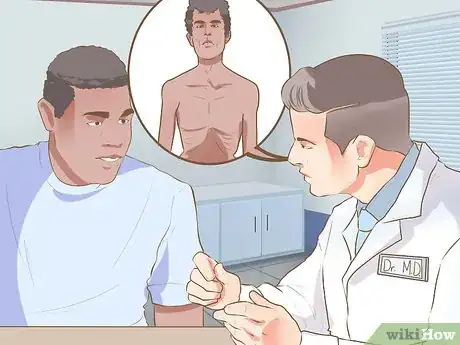


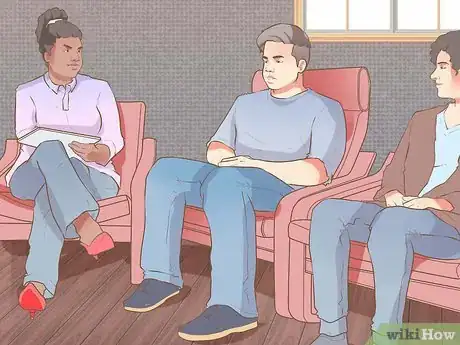
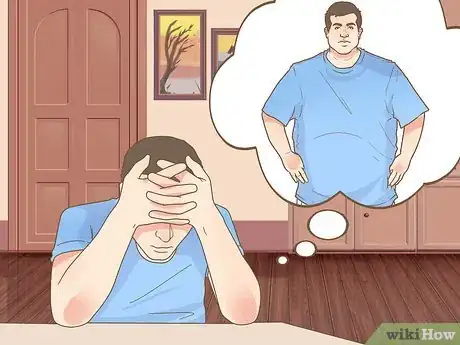

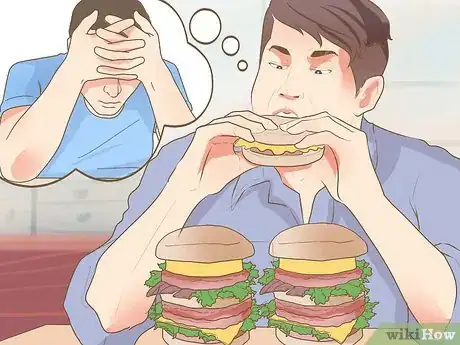
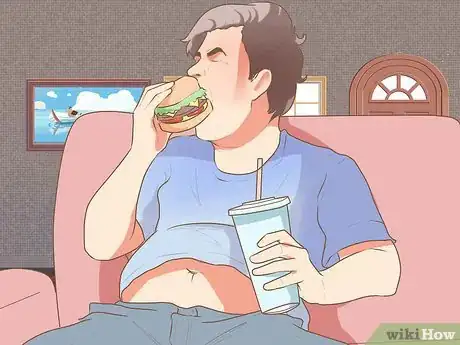
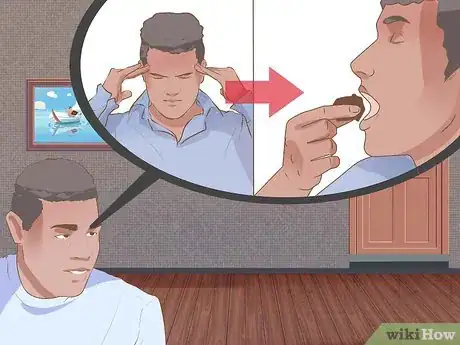
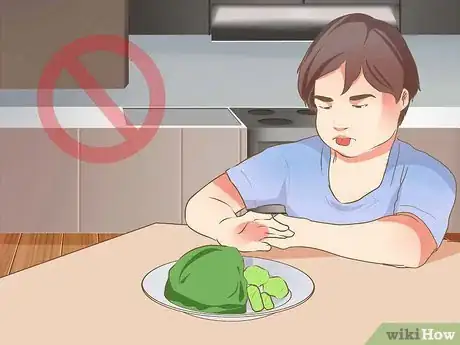




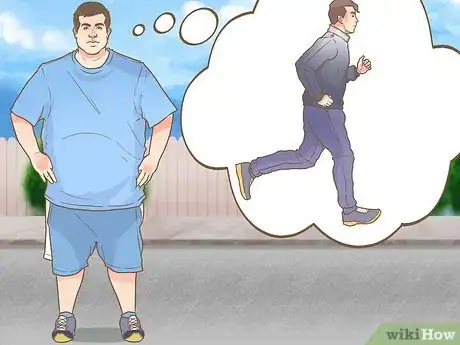
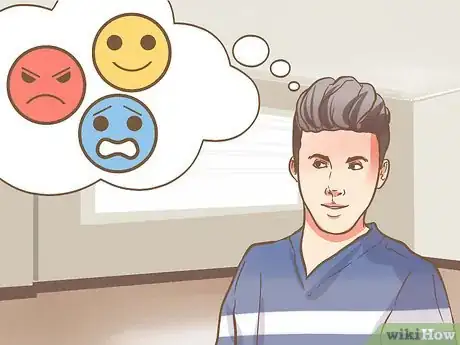

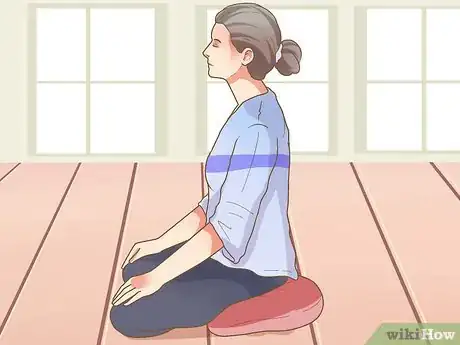





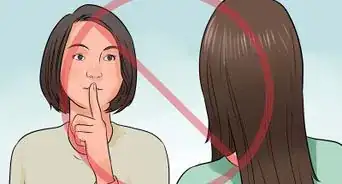







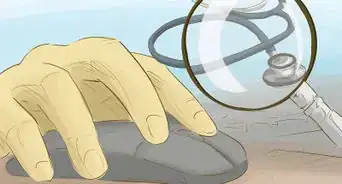













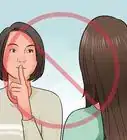



































Medical Disclaimer
The content of this article is not intended to be a substitute for professional medical advice, examination, diagnosis, or treatment. You should always contact your doctor or other qualified healthcare professional before starting, changing, or stopping any kind of health treatment.
Read More...